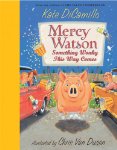Some years ago my daughter gave me the book What the Dormouse said: Lessons for grownups from Children's Books. The marvelous Judith Viorst, a famous children's book author, wrote the forward for the book, and in it she says:
"In my editing days...the children's book department was the patronized kid sister of the far more important, and self important, adult book department, where, it was deemed, the serious action took place. I didn't - and don't - accept this point of view.
For I've always believed that, at their best, the language and art of books for children are as good as it gets. At their best, the subjects treated in these books include almost all our central human concerns. At their best children's books offer insights we'll want to remember and ponder and savor and learn and revel in."
I can remember how excited my child self was when I was able to progress from picture books and simple little chapter books to hefty novels. It was a rite of passage for me, and I was so proud on the day when I left the library with a stack of books that had not come from the children's section. At this point in our lives we are all so eager to do the next 'big thing' that comes with growing up; "onward and upward" is our rallying cry. We set aside the 'babyish' things that we loved, eager to embrace the things that are for people who are bigger and older.
Unfortunately, this can mean that we set aside books that, though they were written for children, have an ageless quality. I know of many people who still love to read the Winnie the Pooh books, particularly in hard times. The sweet humor and gentle wisdom that lies within the Pooh stories can be very healing for a hurt, weary, or anxious adult heart. Often adults are reluctant to admit that Pooh still has the power to delight them because they feel that an adult should only be reading books that are written for adults.
Let us set this idea aside, my friends. Childhood favorites such as The Wind in the Willows, The Secret Garden, Little Women, Anne of Green Gables, Sarah Plain and Tall, Wishtree, Redwall, Harry Potter, and James and the Giant Peach offer us adults a reprieve from our busy and often stressful lives. Some convey a truth, or several truths, that we need to be reminded of. Others make us laugh and lift us up with their extraordinary language.
The books that I will be telling you about in this blog are books for children AND adults. In some cases adults will enjoy a book I mention as they read it to a child, and talk about the subject matter with that child. Adults will learn something new or will be reminded of something important that they have forgotten.
In other cases adults will enjoy reading the books I talk about on their own, for themselves. In these books adults will go on adventures with marvelous characters, they will learn about remarkable people, they will revel in language that is rich and emotive.





